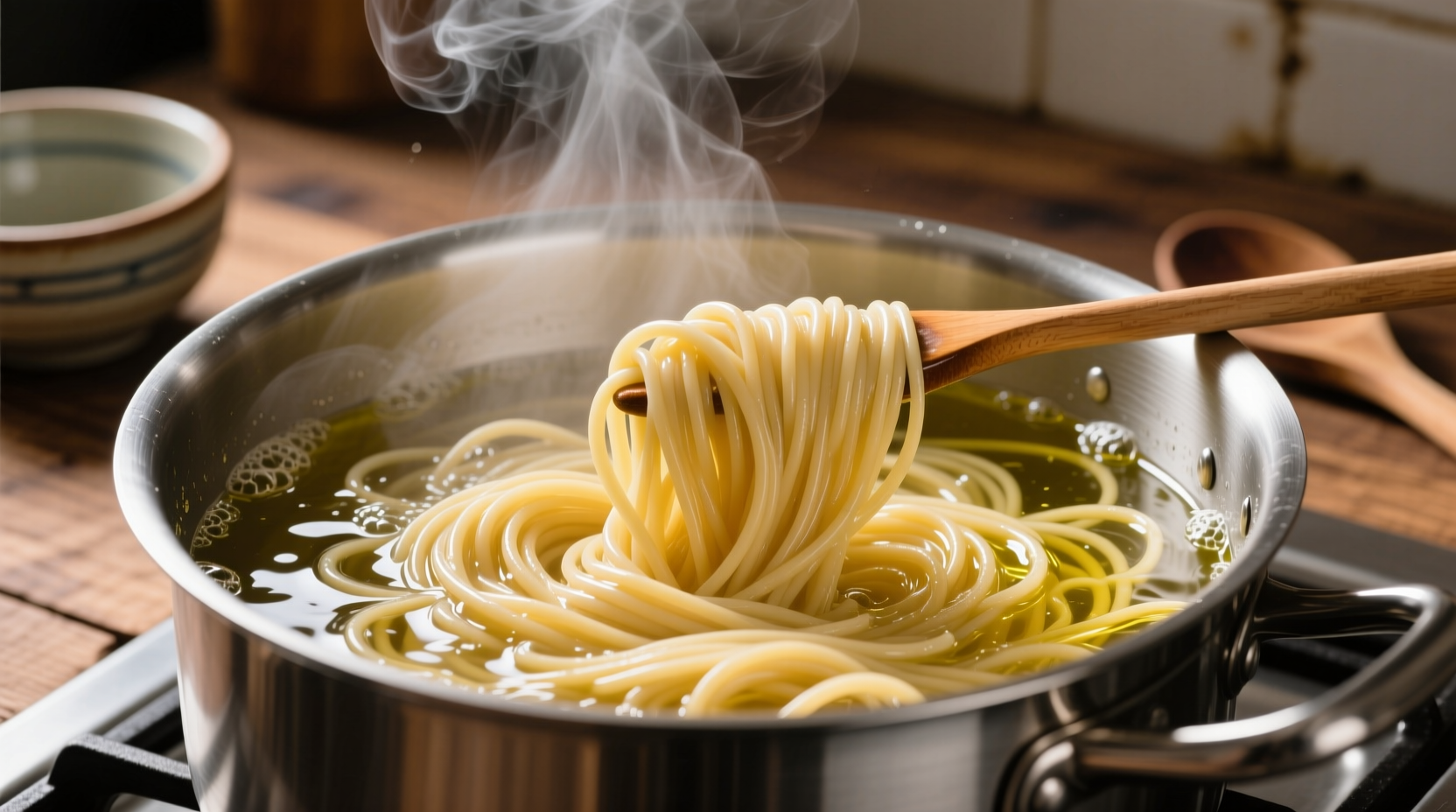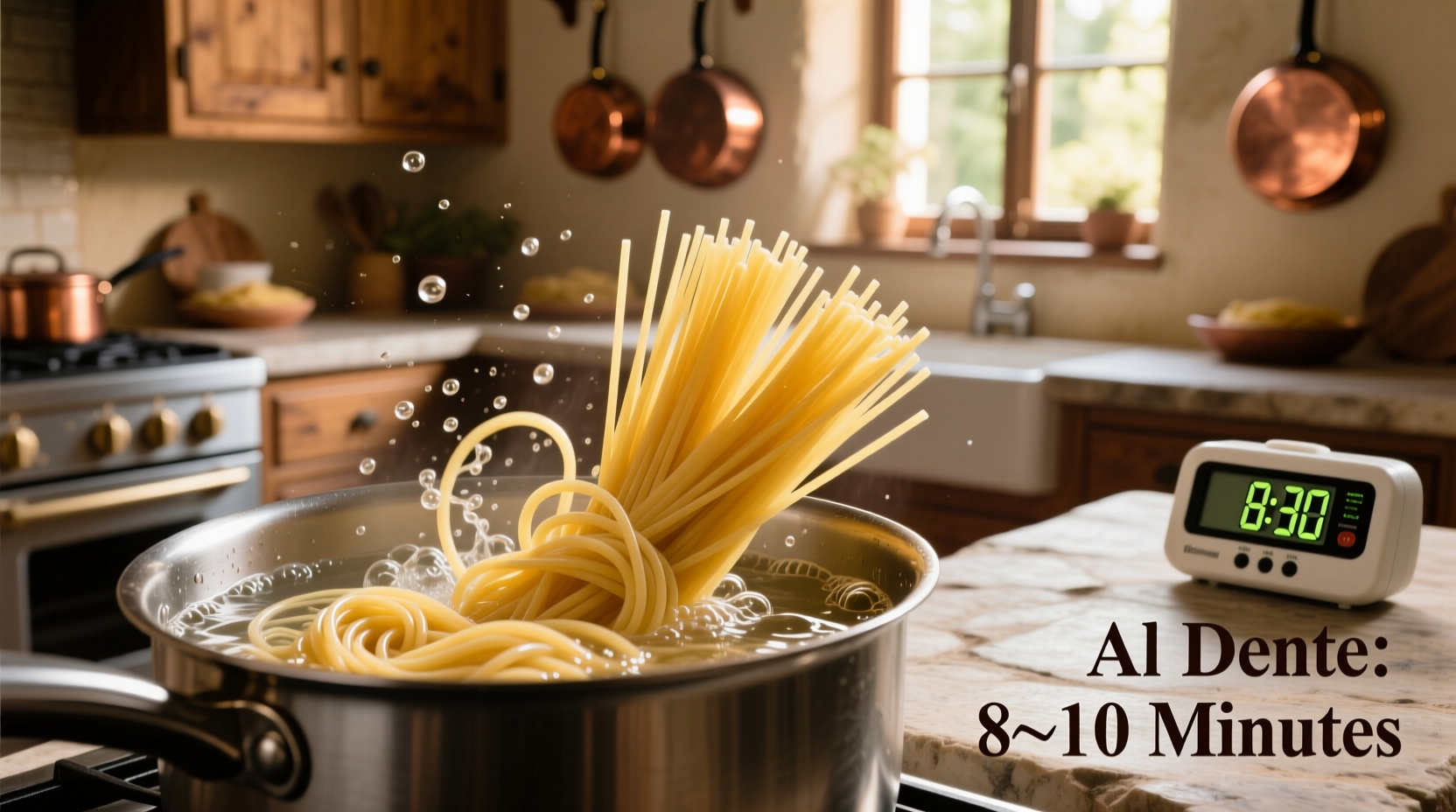The Science Behind Spaghetti Cooking Times
Getting spaghetti timing right transforms an ordinary meal into a culinary delight. Most dried spaghetti varieties require 8-12 minutes in vigorously boiling water to reach perfect al dente texture. This timing isn't arbitrary—it's based on the science of starch gelatinization and protein coagulation that occurs when pasta meets boiling water.
According to the Culinary Institute of America's pasta guidelines, the critical window for optimal texture occurs when the starch granules have absorbed enough water to become tender while the gluten network maintains structural integrity. This precise balance creates that signature al dente "tooth feel" that defines properly cooked spaghetti.
Your Spaghetti Cooking Timeline
Follow this step-by-step cooking journey for perfect results every time:
- Prep phase (2 minutes): Fill a large pot with 4-6 quarts of water per pound of spaghetti
- Boiling phase (8-12 minutes): Once water reaches a rolling boil, add spaghetti and set timer
- Testing phase (starting at 8 minutes): Begin checking texture 2 minutes before package suggests
- Draining phase (immediate): Stop cooking when pasta is slightly firmer than desired
Professional chefs recommend fishing out a strand at the 8-minute mark to begin testing. The Bon Appétit Test Kitchen confirms that spaghetti continues cooking for 30-60 seconds after draining due to residual heat—a crucial factor many home cooks overlook.
| Spaghetti Type | Standard Cooking Time | Al Dente Test Time | Texture Characteristics |
|---|---|---|---|
| Regular dried spaghetti | 9-12 minutes | 8-10 minutes | Firm center with slight resistance |
| Thin spaghetti (capellini) | 6-8 minutes | 5-6 minutes | Delicate with minimal resistance |
| Thick spaghetti (spaghettoni) | 12-14 minutes | 10-12 minutes | Pronounced firm center |
| Fresh spaghetti | 2-4 minutes | 1.5-3 minutes | Soft with slight elasticity |
Factors That Change Your Cooking Clock
Several variables affect how long spaghetti needs to cook. Understanding these helps you adjust timing for perfect results:
Altitude Adjustments
At higher elevations, water boils at lower temperatures, extending cooking times. The USDA Food Safety and Inspection Service recommends adding 25-50% more cooking time above 3,000 feet elevation. For spaghetti at 5,000 feet, expect 12-15 minutes instead of the standard 8-12.
Brand and Composition Differences
Not all spaghetti follows the same timeline. Bronze-die extruded pasta typically requires 1-2 minutes longer than Teflon-extruded varieties due to its rougher surface and denser structure. Whole wheat spaghetti often needs 2-3 extra minutes compared to refined flour versions.
The Water-to-Pasta Ratio Factor
Using insufficient water causes starch concentration to rise too quickly, creating a sticky situation that extends effective cooking time. The Italian Manufacturers Association specifies a minimum 4:1 water-to-pasta ratio by volume to maintain consistent boiling temperature.

Mastering the Al Dente Test
Timing alone won't guarantee perfect spaghetti—testing is essential. Here's how professional chefs determine doneness:
- The Visual Check: Properly cooked spaghetti maintains its shape without bloating or splitting
- The Texture Test: Bite into a strand—it should offer slight resistance at the core
- The Temperature Trick: Remove from heat 1 minute before desired doneness (carryover cooking continues)
- The Cooling Method: Immediately rinse with cold water only if preparing cold pasta salad
Many home cooks make the mistake of relying solely on package timing. The reality? Package instructions provide a starting point, but your specific conditions require adjustments. As pasta expert Marcella Hazan noted, "The only reliable timer for pasta is your own judgment."
Avoid These Common Timing Mistakes
Even with perfect timing, these errors can ruin your spaghetti:
- Adding oil to water: Creates a slick surface that prevents sauce adhesion
- Insufficient stirring: Causes strands to stick together in the first 2 minutes
- Overcrowding the pot: Drops water temperature, extending cooking time unpredictably
- Discarding all cooking water: Loses valuable starchy liquid for sauce emulsification
Remember that spaghetti continues cooking after draining. The Serious Eats Pasta Guide confirms that residual heat adds approximately 30 seconds of cooking time, which is why you should always undercook slightly.
Special Situation Timing Adjustments
Certain scenarios require modified cooking approaches:
For Baked Dishes
When using spaghetti in casseroles or baked pasta dishes, undercook by 2-3 minutes. The additional time in the oven completes the cooking process while preventing mushiness.
For Meal Prep
If preparing spaghetti ahead of time, cook to just before al dente, then toss with 1 teaspoon of olive oil per pound and refrigerate. Reheat by plunging into boiling water for 30-60 seconds.
For Cold Pasta Salads
Cook spaghetti to full al dente, then immediately rinse under cold water to stop the cooking process. This prevents overcooking during cooling and maintains texture integrity.
Expert Timing Tips for Perfect Results
Implement these professional techniques for consistently excellent spaghetti:
- Always salt water after it boils but before adding pasta (1-2 tablespoons per gallon)
- Set multiple timers: one for package time, one for testing time
- Reserve 1 cup of starchy cooking water before draining
- Finish cooking spaghetti in the sauce for 1-2 minutes to enhance flavor absorption
- Never rinse spaghetti unless making cold salad—starch helps sauce cling
Understanding how long spaghetti takes to cook transforms from a simple timing question to a nuanced culinary skill. By recognizing the variables that affect cooking time and implementing proper testing techniques, you'll consistently achieve restaurant-quality results at home.











 浙公网安备
33010002000092号
浙公网安备
33010002000092号 浙B2-20120091-4
浙B2-20120091-4